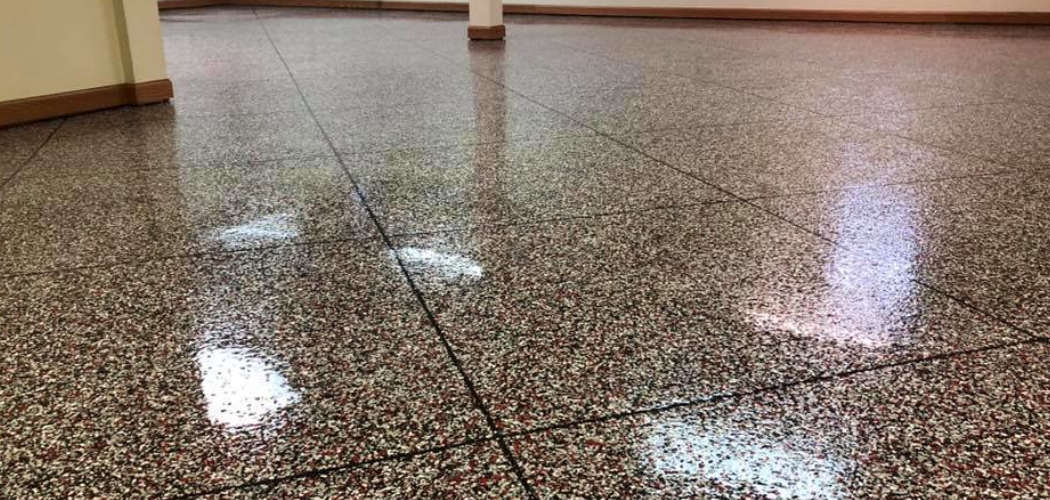If you have marble floors in your home, you know how beautiful and elegant they can make a space feel. However, marble is also a very delicate material that requires proper care and maintenance to keep it looking its best. One of the most important steps in maintaining marble floors is sealing them.
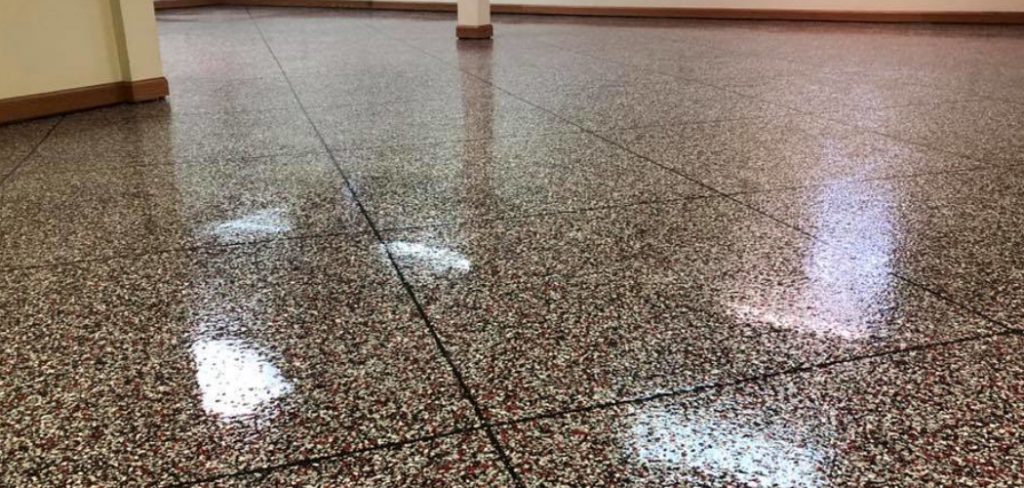
Sealing marble is an essential step in protecting it from stains, scratches, and other types of damage. In this guide, we will discuss the importance of sealing marble floors and provide a step-by-step guide on how to seal marble floors and keep them looking great for years to come.
Understanding Marble Floors
Before getting into the specifics of sealing marble floors, it’s important to understand the nature of this beautiful stone. Marble is a type of metamorphic rock that is formed from limestone over time due to intense heat and pressure. This process results in a unique and luxurious appearance, but it also means that marble is a softer and more porous material than other types of flooring. This porosity makes marble prone to staining, etching, and scratching if not properly cared for.
Why Seal Marble Floors?
Marble is a porous material, which means that it has tiny openings and channels that can easily absorb liquids and other substances. This makes it susceptible to stains from spills, footprints, and even water damage. By sealing marble floors, you essentially create a protective barrier that prevents these substances from penetrating the surface of the stone. Sealing also helps to fill in any microscopic holes or gaps in the marble, making it less likely to absorb stains and damage.
When to Seal Marble Floors?
It is recommended to seal marble floors every 6-12 months, depending on the level of foot traffic and wear and tear. If you have a busy household with kids or pets, it may be necessary to seal your marble floors more frequently. You can test if your marble floor needs to be sealed by dropping some water onto the surface. If the water beads up, then your floor is still protected. However, if the water soaks into the marble, it’s time to seal.
Tools and Materials You Will Need to Seal Marble Floors
- Mild cleaner or soap
- Soft cloth
- Sealer specifically for marble floors (make sure it is water-based)
- Paintbrush or roller
- Clean towel or rag
- Protective gloves and mask (optional)
- Small fan or air mover (optional)
Step-by-step Guidelines on How to Seal Marble Floors
Step 1: Clean the Marble Floor
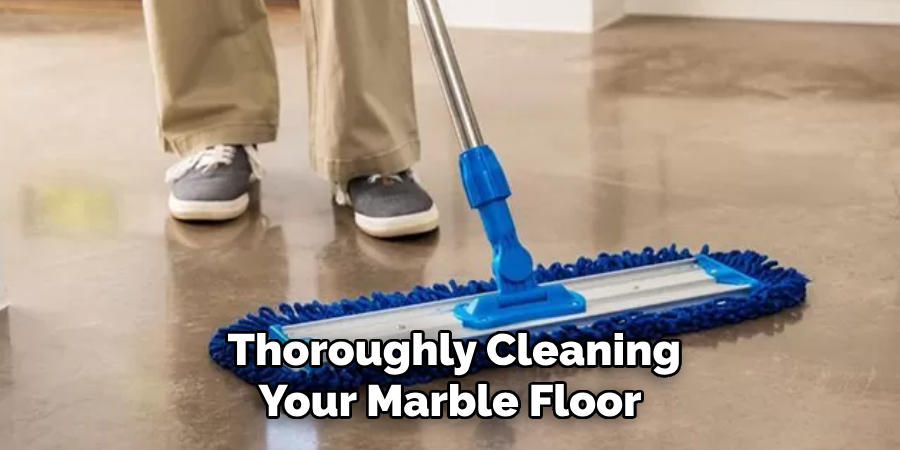
Start by thoroughly cleaning your marble floor. Use a mild cleaner or soap and a soft cloth to remove any dirt, dust, or debris from the surface. Make sure to dry the floor completely before moving on to the next step.
Cleaning the floor before sealing will ensure that no residue or dirt gets trapped under the sealer. If your marble floor has any stains, you can use a specialized marble stain remover to tackle them before sealing.
Step 2: Prepare the Sealer
Choose a sealer specifically designed for marble floors and make sure it is water-based. Water-based sealers are easier to work with and do not emit harmful fumes like solvent-based sealers do. Make sure to carefully read and follow the instructions on the sealer’s label.
If possible, work in a well-ventilated area and wear protective gloves and mask to avoid skin contact and inhaling the fumes. Preparing the sealer properly will ensure that it is evenly applied and provides maximum protection for your marble floor.
Step 3: Apply the Sealer
Using a paintbrush or roller, apply the sealer in thin, even coats. Start from one side of the room and work your way to the other side, making sure to cover every inch of the marble floor. Avoid applying the sealer too thickly, as it can create a cloudy or sticky residue. It’s better to apply multiple thin coats than one thick coat. If you notice any bubbles or excess sealer, use a clean towel or rag to gently remove them.
Step 4: Let the Sealer Dry
After applying the sealer, let it dry for at least 1-2 hours. Make sure to keep the room well-ventilated during this time. If possible, use a small fan or air mover to speed up the drying process. Once the first coat is completely dry, you can apply another thin coat if desired. This will provide an extra layer of protection for your marble floor.
Step 5: Buff the Floor
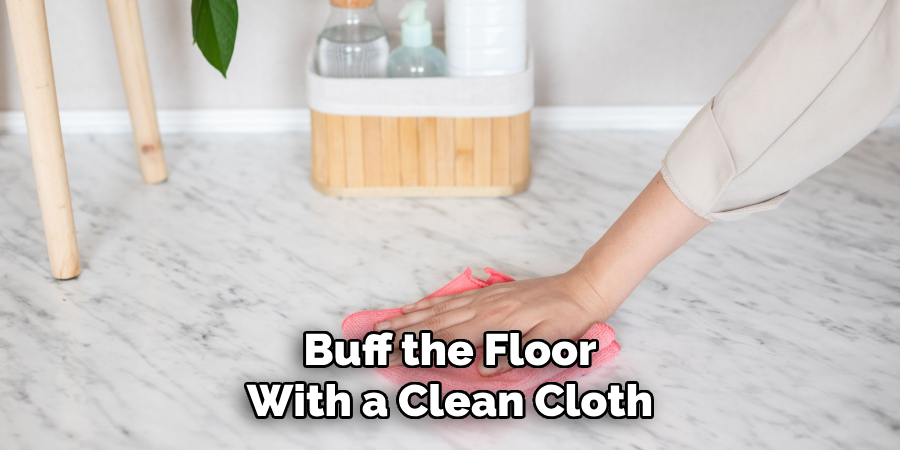
After the final coat is dry, buff the floor with a clean cloth to remove any excess sealer and give it a smooth finish. Make sure to inspect the entire surface for any missed spots or uneven areas. If you notice any imperfections, you can apply another thin coat of sealer to those areas. Make sure to let the sealer dry completely before walking on the floor or placing any furniture back.
Following these simple steps will help you seal your marble floors effectively and keep them looking beautiful for years to come. Remember to regularly clean and maintain your sealed marble floors to ensure they stay in top condition.
With proper sealing and care, your marble floors will continue to add elegance and sophistication to your home for many years ahead. So go ahead, give your marble floors the protection they deserve, and enjoy a stunning, long-lasting flooring option. Happy sealing!
Additional Tips and Tricks to Seal Marble Floors
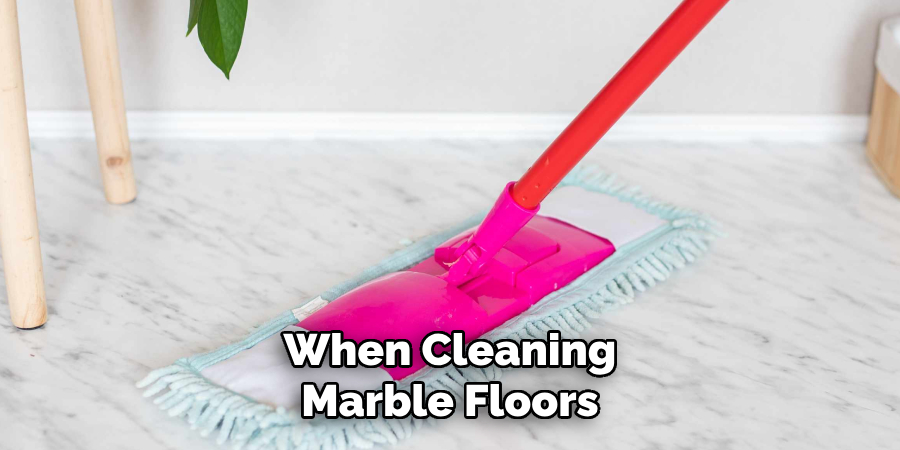
1. When cleaning marble floors, avoid using acidic or abrasive cleaners as they can cause damage to the surface. Instead, opt for gentle, pH-neutral cleaners specifically designed for marble.
2. For tough stains and spills, blot the area immediately with a soft cloth or paper towel. Avoid wiping as this can spread the stain further and potentially scratch the surface.
3. Regularly sweep or vacuum your marble floors to remove any dirt or debris that can scratch the surface. Be sure to use a soft bristle attachment to avoid causing any damage.
4. Use doormats at entrances and high-traffic areas to prevent dirt, grit, and sand from being tracked onto the marble floor which can cause scratches and dullness over time.
5. Place protective pads or felt under heavy furniture to prevent them from scratching or damaging the marble surface.
6. Avoid placing hot items directly on marble floors as they can cause thermal shock and potentially crack the surface. Use coasters or trivets under hot objects to protect your floor.
7. To maintain the shine of your marble floors, use a high-quality marble polish once every few months. This will not only restore the shine but also provide a protective layer against stains and scratches.
8. Always blot up spills immediately, particularly if they are acidic or contain harsh chemicals such as vinegar or bleach. These substances can etch and damage marble surfaces if left for too long.
9. For regular maintenance, use a soft microfiber mop dampened with water to clean your marble floors. Avoid using too much water as excess moisture can seep into the porous surface of marble and cause discoloration.
10. If you have pets, keep their nails trimmed to prevent scratches on your marble floors. Also, be sure to clean up any accidents immediately before they have a chance to penetrate the marble surface.
By following these additional tips and tricks, you can ensure that your marble floors will remain beautiful and pristine for years to come. With the right maintenance and care, your investment in marble flooring will be well worth it, adding elegance and value to your home. So go ahead and enjoy the luxurious beauty of marble without worrying about damaging it!
Things You Should Consider to Seal Marble Floors
1. Type of Marble:
When it comes to sealing marble floors, the type of marble you have plays a crucial role. Different types of marbles require different treatment and sealing methods. Before starting the sealing process, make sure you know what type of marble you have and research the best sealing method for your specific type.
This is one of the most important factors to consider as it will ensure that your marble floors are sealed correctly and avoid any potential damage.
2. Quality of Marble:
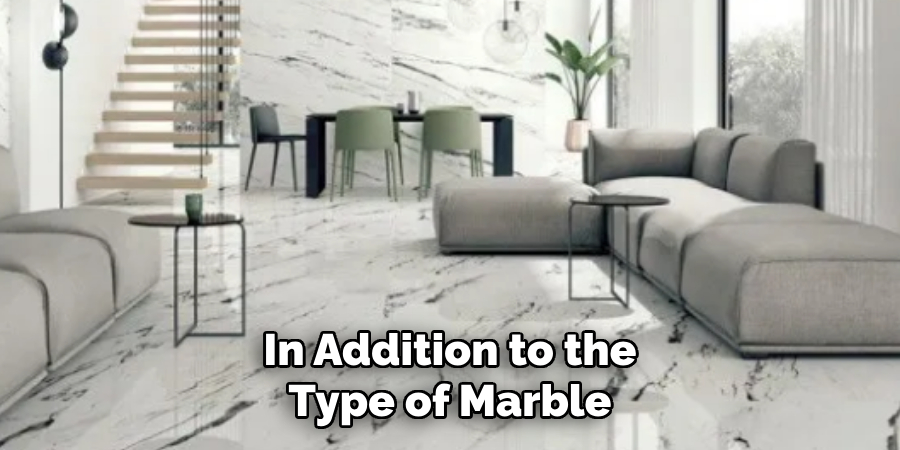
In addition to the type of marble, the quality also matters when sealing your marble floors. Lower-quality marbles tend to have more pores and may require a different type of sealer compared to higher-quality marbles with fewer pores. It is important to inspect your marble floors and determine the quality before choosing a sealer. If the marble has a highly polished surface, it will need a penetrating sealer to ensure the pores are adequately sealed.
3. Age of Marble:
The age of your marble floors is another factor to consider when sealing them. Older marbles may have already been exposed to harsh conditions and require more attention than newer ones. For older marbles, it is recommended to clean them thoroughly before sealing to remove any dirt or grime that may have accumulated over time. Additionally, you may need to apply multiple coats of sealer for better penetration.
4. Amount of Foot Traffic:
The amount of foot traffic your marble floors receive is also an important factor to consider. High-traffic areas such as entryways, hallways, and kitchens are more prone to wear and tear, making them more susceptible to stains and damage. In these areas, it is recommended to use a high-quality sealer with multiple coats for better protection against foot traffic. If you have low-traffic areas, a single coat of sealer may suffice.
5. Climate and Humidity:
The climate and humidity levels in your home can also affect the sealing process. In humid environments, moisture can easily seep into the marble pores, making them more susceptible to stains and damage. In dry climates, the marble floors may become brittle and prone to cracking. It is essential to choose a sealer that can protect against both moisture and dryness, depending on the climate in your home.
6. Maintenance Routine:
Proper maintenance plays a significant role in preserving the seal on your marble floors. It is crucial to regularly clean and maintain your floors according to the manufacturer’s recommendations for the specific sealer you have used. This could include using specific cleaning products or avoiding certain chemicals that may damage the seal. Regularly maintaining your floors will ensure that the seal remains intact and extends its lifespan.
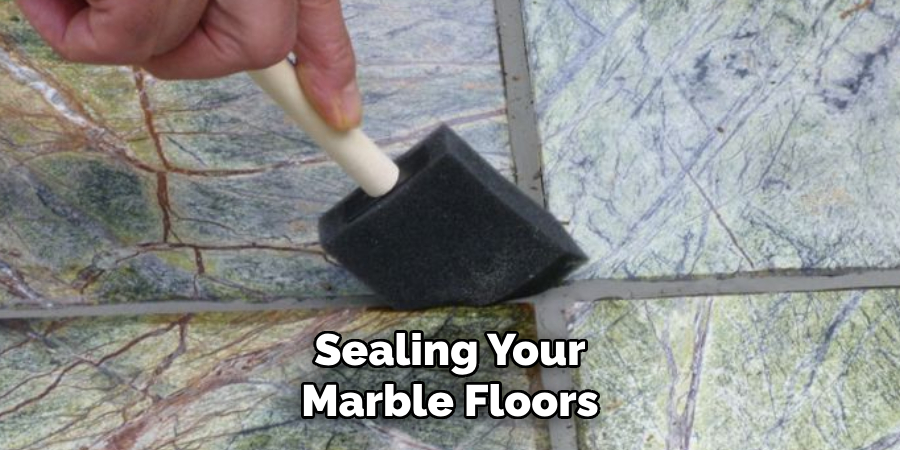
Following these considerations when sealing your marble floors will help ensure that they remain protected and maintain their natural beauty for years to come. It is important to do your research and choose the right sealer for your specific type, quality, and age of marble, as well as the climate and level of foot traffic in your home.
Remember to also follow a proper maintenance routine to keep your sealed marble floors looking their best. So, take your time and give your marble floors the care they deserve for long-lasting beauty and durability. Happy sealing!
Maintenance Tips for Sealed Marble Floors
1. Regular Cleaning:
Regular cleaning is key to keeping your sealed marble floors looking pristine. Use a soft mop or cloth to wipe away any dirt, dust, or debris that may have accumulated on the surface. It is important to avoid using abrasive cleaners or tools as they can damage the sealant and dull the shine of your marble floors. Instead, opt for a pH-neutral cleaner specifically designed for use on marble surfaces.
2. Promptly Clean Up Spills:
Marble is a porous material and any spills should be cleaned up immediately to prevent staining. Use a clean cloth or paper towel to blot the spill, rather than wiping it, as wiping can spread the spill and potentially damage the sealant. For tough stains, a mild soap solution with warm water can be used. Just make sure to thoroughly rinse and dry the area afterward.
3. Avoid Harsh Chemicals:
Avoid using harsh chemicals such as bleach, ammonia, and vinegar on sealed marble floors as they can damage the sealant and cause discoloration. These products are also acidic, which can eat away at the surface of your marble floors over time. Stick to gentle cleaners specifically made for use on marble surfaces. If unsure about a product, always do a spot test in an inconspicuous area first.
4. Use Protective Mats and Pads:
To prevent scratches and damage from furniture or heavy foot traffic, use mats and pads on your sealed marble floors. Place them under furniture legs and at entryways to catch any debris that may be tracked in. This will not only protect your floors but also prolong the life of the sealant. Using rugs in high-traffic areas can also help to minimize wear and tear on your floors.
5. Avoid High-Impact Activities:
Avoid high-impact activities such as running or jumping on sealed marble floors as they can cause cracks or chips. Also, be mindful of dropping heavy objects on the floors as this can also cause damage. If you have pets, keep their nails trimmed to prevent scratches on the surface of your floors. If any damage does occur, it is best to have it repaired by a professional to ensure it is done correctly.
6. Schedule Regular Maintenance:
Even with proper care and maintenance, sealed marble floors will eventually need to be resealed. This should be done every 1-2 years depending on the amount of foot traffic your floors receive. It is best to hire a professional to do this as they have the expertise and tools necessary to properly seal your floors and prevent any potential damage.
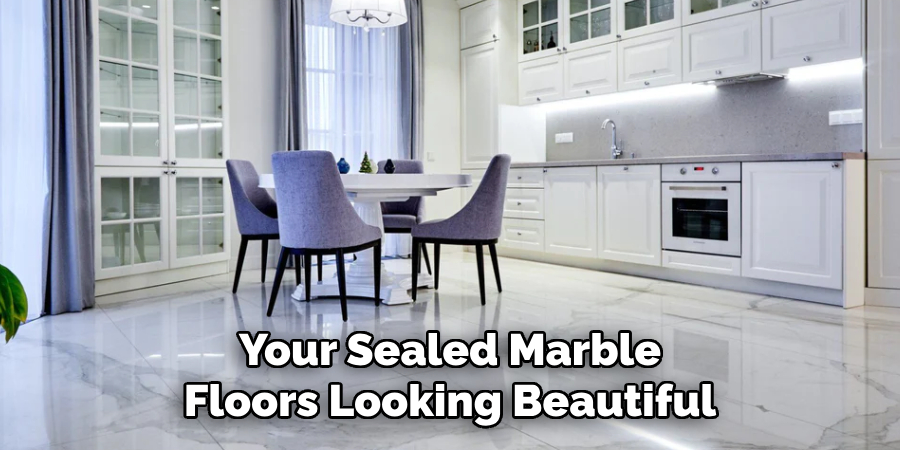
Following these maintenance tips will not only keep your sealed marble floors looking beautiful but also extend their lifespan. By taking proper care of your floors, you can enjoy the elegance and luxury of marble for years to come. So be sure to regularly clean, promptly clean up spills, avoid harsh chemicals, use protective mats and pads, avoid high-impact activities, and schedule regular maintenance for your sealed marble floors. Happy cleaning!
Frequently Asked Questions
Can I Seal My Marble Floor Myself?
Yes, you can seal your marble floor yourself using a high-quality sealer and follow the manufacturer’s instructions carefully. However, it is recommended to hire a professional for the best results, especially if you have never sealed a marble floor before.
How Often Should I Seal My Marble Floors?
It is generally recommended to seal marble floors every 6 to 12 months, depending on the amount of foot traffic and use your floor receives. Factors such as spills and exposure to harsh chemicals can also affect the frequency of sealing.
Do I Need to Prep My Marble Floor Before Sealing?
Yes, it is important to clean your marble floor thoroughly before sealing. This includes removing any dirt, dust, and debris from the surface using a mild cleaner. It is also recommended to remove any stains or scratches before sealing to ensure a smooth and even application.
What Type of Sealer Should I Use?
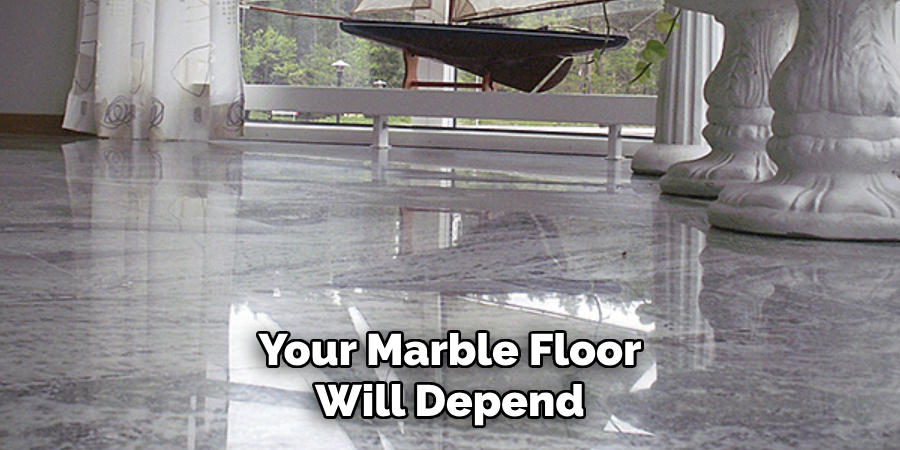
There are various types of sealers available for marble floors, including penetrating sealers, topical sealers, and impregnating sealers. The best type of sealer for your marble floor will depend on factors such as the type of marble, level of use, and desired finish. It is recommended to consult a professional or do thorough research before choosing a sealer.
Conclusion
Now you know how to seal marble floors and the importance of sealing them regularly. Remember to clean and prep your floor before applying a high-quality sealer for the best results.
If you are unsure about how to properly seal your marble floor, it is always best to consult a professional for guidance. Keep your marble floors looking beautiful and protected with regular sealing. So, go ahead and give your floor the care it deserves. Happy sealing!
